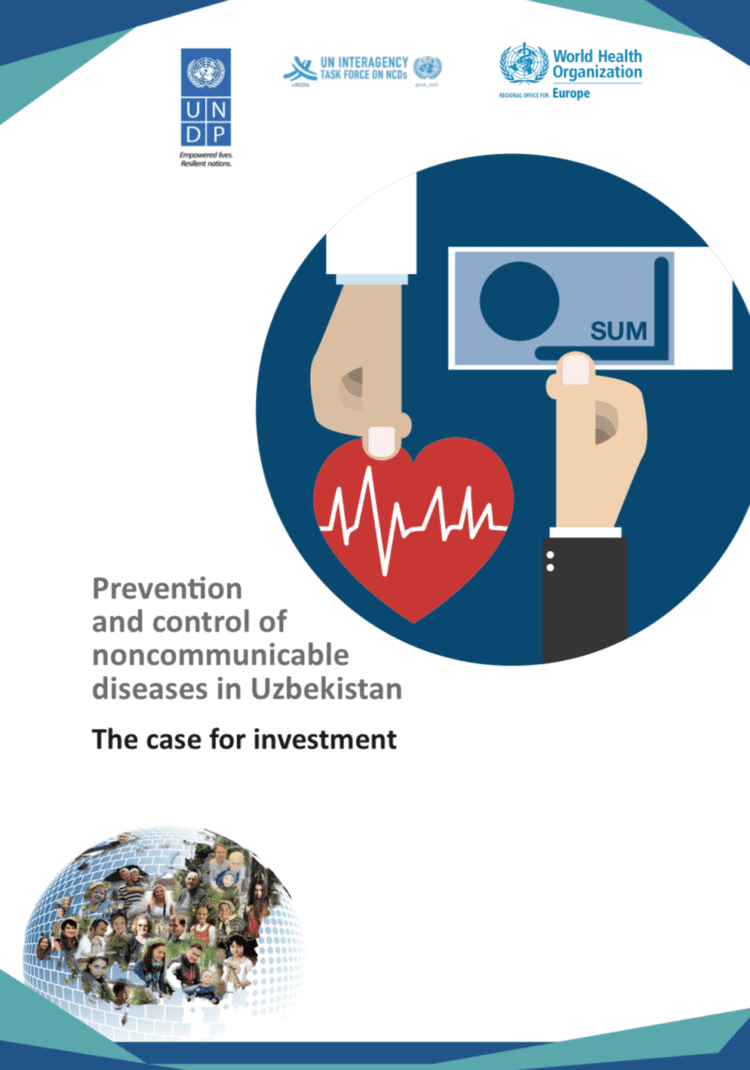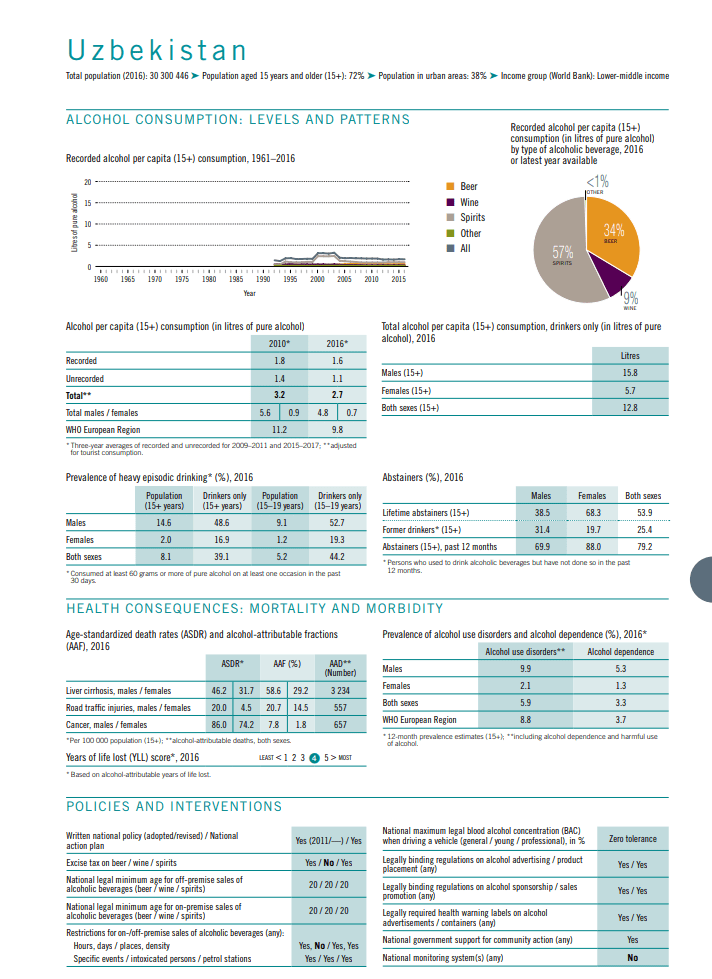WHO Europe: Uzbekistan Case for Investing in NCD Prevention
 A new report by the WHO European Regional Office and UNDP provides evidence that NCDs and their risk factors such as alcohol use is a major obstacle to development in Uzbekistan. The report is entitled “Prevention and control of noncommunicable disease in Uzbekistan. The case for investment (2018)” and calls for greater action in the prevention of NCD risk factors and sets forth cost-benefit analyses of proposed intervention packages targeting NCD risk prevention.
A new report by the WHO European Regional Office and UNDP provides evidence that NCDs and their risk factors such as alcohol use is a major obstacle to development in Uzbekistan. The report is entitled “Prevention and control of noncommunicable disease in Uzbekistan. The case for investment (2018)” and calls for greater action in the prevention of NCD risk factors and sets forth cost-benefit analyses of proposed intervention packages targeting NCD risk prevention.
According to the report, NCDs are the cause of 79% of all death in Uzbekistan. The probability of premature death resulting from NCDs was over 1 in 4 people in 2015. NCD related premature death, increased morbidity and disability is posing a significant barrier to socioeconomic development in the country. In 2016, the government is estimated to have spent 2.1 trillion in total for treatment of the four main NCDs: cancer, cardiovascular disease (CVD), diabetes and chronic respiratory disease. The hidden additional costs due to loss of productivity is over 3 times the government health care costs of NCDs at 7.3 trillion total.
In this view, the report focuses on the returns from investing in a multi-sectoral prevention mechanism of NCDs by preventing the major risk factors including alcohol consumption.
Alcohol use is of concern in Uzbekistan since, on average, men consume alcohol six times as much as women and one in nine male alcohol users binged (consumed six or more alcoholic drinks in one sitting) in the past month. Alcohol attributable NCDs include multiple forms of cancer, pancreatitis, epilepsy, diabetes, cirrhosis and Ischemic Heart Disease (IHD), stroke and other cardiovascular and circulatory diseases.
Alcohol Policy in Uzbekistan
The report states overall the alcohol policy and regulatory documents in Uzbekistan are fairly strong. Uzbekistan currently uses the 3 alcohol policy best buys, and two effective interventions recommended by WHO. However gaps were found at the implementation level.
Taxation: By law, Excise tax is a must for alcohol sale. Excise taxes are increased annually based on a formula. But the retail price of alcoholic beverages remains low comparative to other countries of the European region.
Advertising: Alcohol advertising is banned including event sponsoring, and placing trademarks on clothing. Promotion of alcohol consumption is banned but happens through product placement in movies. Advertising in sales points may also occur.
Availability: Alcohol is only sold in licensed premises. Restrictions on alcohol sales exist in terms of hours, retail sale location (ban on retail sale within 500 meters of educational, sports and religious institutions) and age (minimum age to purchase alcohol is 20 years). There are rules on the maximum amount of alcohol which can be sold to a customer and supply can be refused to a person already intoxicated.
Driving under the influence of alcohol: There is no defined permissible Blood Alcohol Level when driving. However drink driving is a crime punishable law. The conditions of punishment are tough, which includes high fines up to imprisonment. But implementation is not strong as all police cars do not have breathalyzers. Therefore, suspected drivers are sent for medical intoxication testing. In 2017, 135 000 drivers underwent medical examination for intoxication, but only 75 000 cases were proved.
Brief interventions: A new WHO toolkit on alcohol screening and brief intervention was used for training narcologists and trainers for primary health care settings in April 2017. Brief interventions on alcohol and motivational interviewing are also part of the integrated NCD prevention training package for primary health care doctors and nurses as part of the WHO package of essential noncommunicable disease interventions (PEN) project within two regions in Uzbekistan. Otherwise, brief interventions are not part of routine care in primary health care.
The current level of implementation of the mentioned policy and regulations are estimated as follows:
- Enforce restrictions on availability of retailed alcohol: 75%
- Enforce restrictions on alcohol advertising: 75%
- Enforce driving under the influence of alcohol laws (sobriety checkpoints): 50%
- Raise taxes on alcoholic beverages: 50%
The assessment in this report is in line with the WHO NCD progress report of 2017 (WHO Regional Office for Europe, 2017). According to which the overall implementation of alcohol control measures is “partly achieved”. Fairly strong regulatory measures are in place but are not strictly enforced.
Facts from the report are further strengthened through the WHO country profile for alcohol for Uzbekistan, which states the country lacks a national monitoring system for policies and interventions. In a country where almost 80% (79.2%) of the people are abstainers, for alcohol users the harm is still high. This is indicated by high heavy episodic consumption and increased prevalence for alcohol use disorders and alcohol dependence among men. The threat of alcohol use to development is evident as Uzbekistan is rated high for years of life lost due to alcohol.
Returns from Investing in NCD Risk Prevention
The OneHealth tool encompassing multiple NCD risk prevention interventions is proposed for Uzbekistan to bring the implementation of policies and regulation to 100%.
The direct and indirect cost and economic burden of NCDs comes up to 9.4 trillion total, the figure could be even more. The costs for conducting interventions to prevent NCDs for 5 year and 15 year periods are estimated. The estimated cost of the alcohol control package is 11.7 billion for 5 years and 89 billion for 15 years.
The benefits far outweigh the costs.
Estimated health benefits of the alcohol interventions over 15 years are as follows:
- Strokes averted: 28 721,
- Acute IHD averted: 20 324,
- Mortality averted: 7 328 and
- Healthy life-years gained: 97 861.
These are the benefits only from the alcohol interventions. All the proposed interventions for NCD risk factor prevention have an estimated return of investment far exceeding the current cost and economic burden of NCDs for Uzbekistan.
Next Course of Action for Uzbekistan
The report provides clear evidence on the economic burden of NCDs, cost of interventions and cost-benefit analysis of implementing the interventions. The estimated benefit for Uzbekistan far exceeds the costs in terms of mitigating the 4 main NCDs and in gaining increased productivity at work.
While Uzbekistan has several policies and regulation frameworks in place for NCD risk prevention, there is no multi-sectoral, integrated national plan to prevent NCDs. According to the report, Uzbekistan will gain greater return on investment by implementing such an integrated approach through the suggested intervention packages.
—
